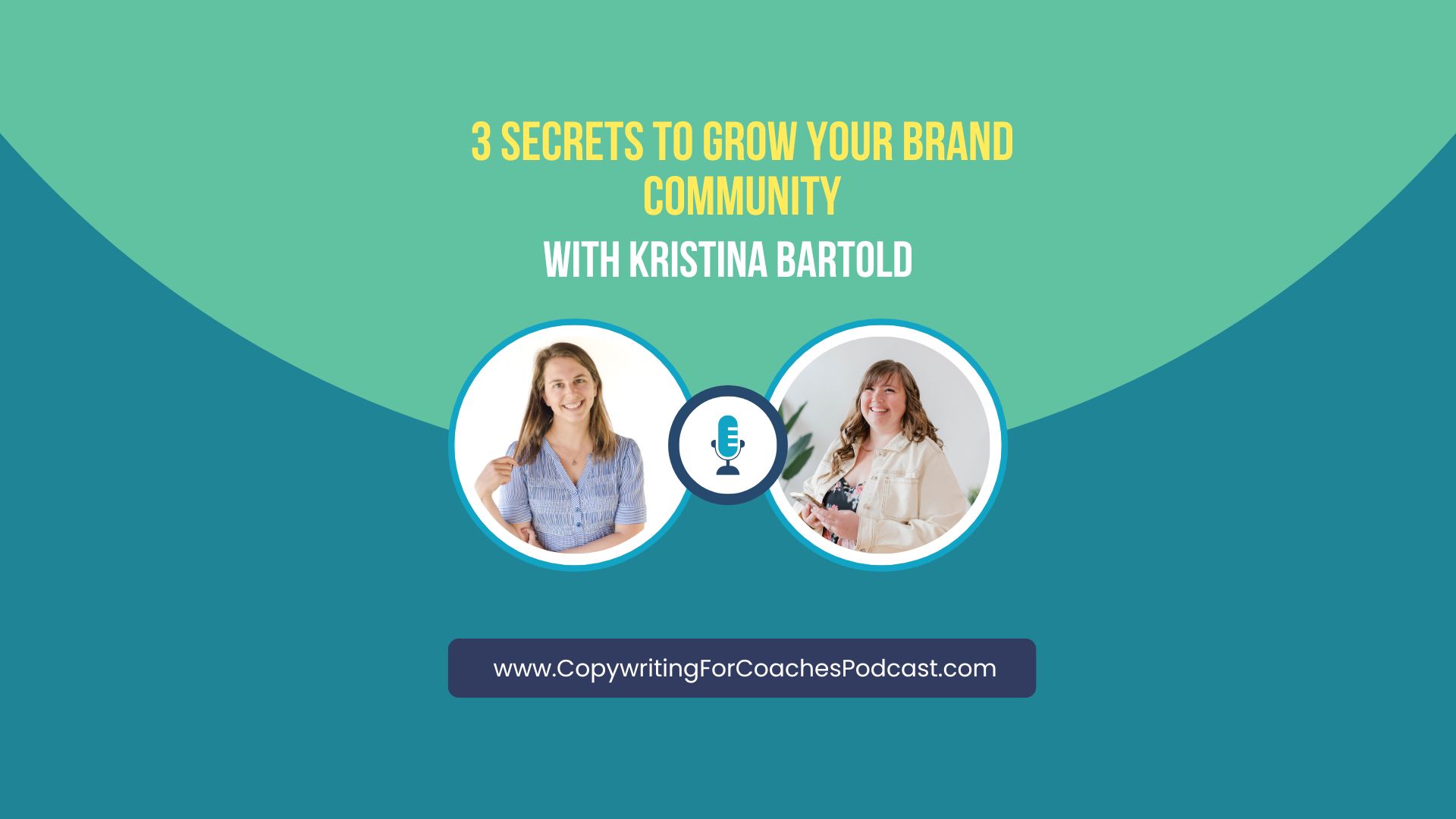If your website copy sounds generic, your social media captions fall flat, and your emails feel like a chore to write…Those are all signs that you might not have a clear grasp on your authentic brand voice.
This guides you through the steps that brand strategists take to uncover a brand’s true essence. You’ll learn how a strong brand voice translates into powerful copywriting, building trust and attracting your ideal clients.
We’ll also explore the emotional connection that a genuine brand voice fosters, and crafting messaging that resonates with your audience and allows you to connect on a deeper level. This is your roadmap to mastering your authentic brand voice. Let’s ditch the marketing jargon and write copy that truly reflects your brand’s unique personality!
How Do You Master Your Authentic Brand Voice?
Mastering a brand’s voice is more than simply writing the way that you speak (though that is often a good start). It requires going deep—beyond surface impressions. It’s a balance between using what your client is saying AND how you express that. Here’s how you can achieve that:
1. Market Research and Client Surveys:
Ask previous and current clients, as well as people in the brand’s life, to identify common patterns in how they perceive the brand. Often, there are insights that the brand itself may not be aware of until they see them reflected back.
2. Self-Reflection and Authenticity Check:
Ask yourself and your client critical questions. Is the voice you’re projecting aligned with the brand’s actual personality, or are you conforming to perceived norms? Have external influences unintentionally altered your brand’s authentic voice?
3. Client Consultation:
Engage deeply with the client to uncover what feels natural to them. Many clients aim for a professional tone, assuming it’s necessary for credibility. However, authenticity often resonates more powerfully. Understand what resonates with their audience and adapt accordingly.
4. Recording and Listening:
Record conversations with the client and listen closely to their natural speech patterns. Pay attention to their exact words and descriptors. This helps in understanding how they naturally communicate and ensures that their brand voice reflects their true self.
5. Community and Feedback:
Involve the brand’s community in the process. Ask for input on how they perceive the brand’s communication style. This external feedback can validate or refine your insights into the brand’s authentic voice.
6. Reflecting and Refining:
Continuously reflect on what the brand values and how they are perceived by others. Look for recurring themes and traits that define their communication style. This process acts as a gut check, ensuring that the brand remains true to itself.
Mastering a brand’s voice isn’t about fitting into a mold—it’s about uncovering more of who you truly are. By going deep, reflecting authentically, and engaging genuinely with clients and their community, you can reveal an authentic brand voice that truly connects with its audience.
What is the Role of Copywriting in Branding?
Copywriting creates and spreads brand identity. First get clear on who you are, what you do, who you do it for, and why it’s different. This clarity then informs your copy, language, and messaging. From there, you can move on to colors, fonts, logos, and website design. Having all your copy written before choosing a template or website design ensures a stronger, more cohesive message.
Copywriting is essential for expressing your brand’s voice across various platforms like your website, social media, and emails. Copy takes the foundational elements of branding and makes them expansive and real. Words have the power to make everything feel tangible and authentic.It is often underestimated but is one of the most impactful aspects of branding. Good copy hits messaging pillars that ensure every piece of content aligns with the brand’s voice and values. Without it, you might end up throwing spaghetti at the wall, hoping something sticks.
Copy translates that big-picture brand vision into words on the page, working hand-in-hand with visuals to create a consistent ecosystem. When your messaging is consistent, it builds trust. When people meet you in person, it should feel the same as when they interact with your brand online.
This is where the power of finding your right-fit copywriter comes in. I have a whole blog article about “Do You Really Need To Hire A Copywriter In Your Business?” But I want to highlight how the brand strategists see it in the section below…
Finding The Right Copywriter For Your Authentic Brand Voice
Finding the right copywriter involves more than just picking someone who can write well. It’s about finding someone who can speak in your brand’s voice, pay attention to detail, and understand your market and industry specifics.
The two biggest barriers to hiring a copywriter are most often the cost and the fear of losing control over your voice. Many worry that no one else can convey their message or have had poor experiences in the past. However, valuing your time and focusing on your strengths is crucial. Some clients prefer to write their copy, but others benefit from a fresh perspective and saved time with an expert.
Visuals capture attention first, but copywriting builds and maintains relationships. A good copywriter can bring your brand story to life with emotion and authenticity, something AI can’t achieve. They help define your brand’s personality—whether funny, straightforward, or storytelling—and ensure it resonates with your audience.
A skilled copywriter will uncover your unique angle of mastery and communicate your expertise effectively. They address root causes of problems, not just symptoms, creating a deep connection with your audience.
The Branding Process For A Team Member To Understand Your Authentic Brand Voice
After interviewing 11 brand strategists, their processes varied slightly, but here is the overarching stages of brand development:
1. The Initial Questionnaire
Write about your core offers, who your target market is, SWOT analysis, what you want your brand to convey, and what you care about.
2. The Kick Off Call
Have a discussion around those questions, get more details, and look for common themes. This is about probing deeper, follow up questions, and getting clarity with “what do you mean by that?”
3. Market Research
Look at competitors and their positioning, map out buyer’s journey, survey or stakeholder interviews. The goal here is to develop the market positioning statement (what your competitive advantage is)
4. Your Comprehensive Brand Guide
This is the final product that you can tangibly use in your business to give to a copywriter, graphic designer, and others on your team so that everything remains cohesive. As a copywriter, I love being able to see your brand book because it allows me to know you better more quickly and ask more nuanced questions so you don’t have to rehash things you’ve already said before. A brand guide includes:
- Who are you, what do you do, and who is it for.
- Mission statement—and why this matters.
- Brand values—how they are defined in your business and your audience.
- Audience – who specifically are you talking to? Who will get the best results by working with you?
- Brand Voice – how you talk about what you care about.
- Core Messages – marketing speak snippets, headlines, subject lines, IG bio blurb
5. Final Call
To walk through every element to make sure it sits right and sounds right.
As a copywriter, I’ve worked with people who have gone through this branding process…and those who haven’t. And while it is not a necessary prerequisite, it does make the process a lot easier—and saves me a lot of time, too! If you don’t have one already, I will create one for you. Not all copywriters do this—in fact, most don’t. The way I see it is that if I am spending hours researching your brand and your voice, I don’t want that to live and die with me. I want you to have that asset, beyond our work together.
A strategy is only as good as implemented. A brand guide is a fantastic asset and provides a consistent, clear, and confident foundation…but not if it collects digital dust. A copywriter turns your brand into marketable assets that can bring in a direct ROI.
What Strategies Do You Use to Connect Potential Clients to a Brand Emotionally?
To truly connect with clients on an emotional level, and to build strong client relationships and loyalty, implement these 4 tips.
Tell Stories
Storytelling is one of the most powerful tools for creating an emotional connection. Share who you are, what you believe in, and the reason you created your business. By understanding your client and connecting their dreams to your brand, you create a sense of community and belonging. It’s not just about selling a product; it’s about being part of something bigger.
Your values, what you do and don’t believe in, are what create the stickiness of a brand. We want depth and soul, not a superficial facade. By being honest and vulnerable about your own journey, you create a connection with your audience. If it feels weird to talk about yourself, remember that it’s not really about you—it’s about making your audience feel seen, known, and understood.
You never know how many people you might inspire with your journey. Your story has shaped who you are today, and it is part of your authentic brand voice. Your brand will grow and change over time, and it’s important to acknowledge this evolution.
Be Authentic With An Appropriate Level of Vulnerability
Being your true self isn’t always easy. It doesn’t mean you have to share every detail about your personal life, but it does mean being real. When you are genuine, you create a connection with your audience because they see you as an actual person, not just a faceless brand. This authenticity can lead to better client experience and retention, building rapport and making your brand more relatable.
Consider Your Audience Journey
How do you want your intended audience to feel as they navigate through your brand from the entry point to the end point? Get an understanding of where your audience is when they find you. Let them know you understand their situation and show them how it can be different. Explain the transformation they can expect from working with you. Show a deep understanding of their needs and wants, and then illustrate how you can help them solve their problems.
Lead With Empathy and Values
Be in tune with your audience and their values. Values are your emotional touchpoint—they are your gut check, your operations manual, and how you show up in the world. They are your differentiator. Talk about your values both implicitly and explicitly. Your values fuel your brand’s actions and messaging, even if you don’t always cite them directly.
This is about creating genuine connections. An authentic brand voice is about being true to yourself and your values, and letting that authenticity shine through in every aspect of your brand.
Copywriting Tips To Convey Brand Identity In Your Authentic Brand Voice
Crafting an authentic brand voice that truly conveys your brand identity can be a game-changer. Here are some tips to help you get there:
Craft a Mission Statement You’re Passionate About
Your mission statement is the heart of your brand identity. It’s more than just a tagline. This is your declaration of your core values and what you stand for.
Incorporate quirky phrases that are unique to your business
What are phrases you say all the time? It can be things you always say to your clients, or your way of speaking outside of business. These can become a signature phrase or thing that your audience associates with you. For example, we all know Jenna Kutcher started as a photographer with a Craigslist camera. Entrepreneurs talk about how “everything is figureoutable”—that’s Marie Forleo. Think about Steve Jobs’ iconic black turtlenecks.
I even noticed this while reading Winnie the Pooh with my kids:
-
- Pooh Bear always says “Oh bother!”
-
- Tigger calls him “buddy boy!”
In this context, some more typical phrases we come across are if you say “ya’ll” or “girlie” or “hey sister” when you are talking to your people.
Just Start Writing
Don’t overthink it—especially your first draft. Get your thoughts on paper, then we can work with them from there. Work in reverse by getting all your thoughts out first, then refine your content to ensure it conveys your authentic brand voice. Check if it brings out your brand personality, hits your key messaging, and aligns with your brand strategy. Remember, nothing is perfect on the first try.
Utilize Social Proof
Don’t underestimate the power of social proof. Highlight how many clients you’ve worked with and their success stories. This not only builds credibility but also reinforces your brand’s reliability and effectiveness.
Try A Done-With-You Session With A Copywriter
If you’re struggling to articulate your ideas in emails or on sales pages, consider hiring a professional copywriter. There are so many benefits to a DWY session, beyond the actual copywriting. Check out this case study where I helped a client make $6000 from just a 1-hour session.
A copywriter can help you craft cohesive and compelling content across your website, sales pages, and email sequences. We ensure everything looks and feels consistent, keeping your authentic brand voice intact.
When you hire an expert, they can help you go all in on your brand’s messaging. They will guide you on whether to prioritize your website, sales page, or email sequences first. An experienced copywriter will work with you to implement your strategy effectively, helping to maintain a cohesive brand presence.
Creating and maintaining an authentic brand voice requires intentionality and consistency. By implementing these 5 tips, you can ensure your brand’s identity is conveyed clearly and effectively, resonating deeply with your audience.
Uncover Your Authentic Brand Voice To Connect Deeply With Your Audience
Don’t settle for a generic copy that leaves your audience scrolling past bored. Uncovering your authentic brand voice allows you to connect with your ideal clients on a deeper level. Ditch the jargon, embrace your brand’s unique personality, and let your voice shine through in every word you write. The result is a loyal following who resonates with your message and is ready to join you on your brand journey. After all, trust is built just like any strong relationship: by showing up consistently, acting in line with your values, and keeping things clear and concise.
An authentic brand voice is the foundation for building a brand your audience can truly connect with. If your brand voice feels convoluted, you’re doing too much. That’s where I can help! Download my free Services Guide for DFY & DWY copywriting support. Discover how I can craft powerful messaging that reflects your brand’s unique personality. Let’s find the right words and create copy that both resonates with your audience and drives results.
Thank you to the brand strategists who contributed to this series:
Areanna Arclese
Fabi Paolini
Ashlee Sang
Mallory Musante
Emily Hunt
Kate Hejde
Terrica Strozier
Mallika Malhotra
Alexis Underwood
Jasmine Haitalani
Tiffany Neuman
This is part 2 of my brand strategist interview series. You can find part 1 on mastering authentic brand messaging by clicking here and part 3 on effective brand copywriting examples, top branding tools, and future trends by clicking here.




